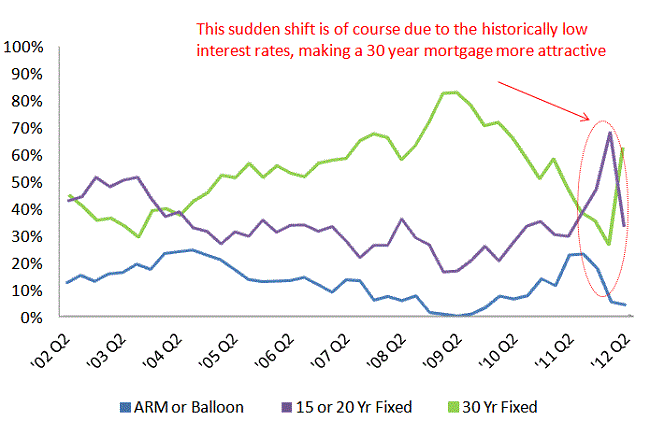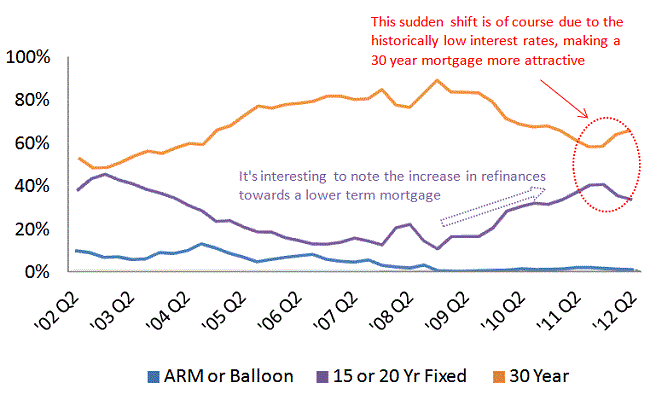Aug
Price conscious customers are always looking for the best deal. How often and to what extent do households shift their mortgage type or structure because of a lower rate and/or some other reason? The answer is all the time, such as when individuals:
- Refinance an adjustable rate mortgage (ARM) into another ARM, 15 year fixed mortgage; a 20 year fixed mortgage, or a 30 year fixed mortgage.
- Refinance a fixed rate mortgage into another fixed rate mortgage or even an ARM.
It all depends on how you view the future of interest rates, how your banker or loan officer views the future of interest rates, and your expected future income, among other things.
With this background in mind, what does the recent data on mortgage refinancing say about what mortgage holders are up to? Let’s review some examples of the variations listed above.
Households refinancing a 1-year ARM into other loan types
- The second quarter of 2012 saw a big shift in the percentage of 1 year ARM holder shifting to 30 year fixed mortgages, with the total percentage going from 26% in the first quarter to 63% in the second quarter.
- The gain in the refinancing activity to 30 year came at the expense of 15 year fixed mortgages, which saw a drop from 58% of all 1 year ARM refinancing activity in the first quarter of 2012 to 21% in the second quarter.
Why was there such a large shift from ARMs to a 30 year? The answer is of course the historically low long term interest rates – and thus mortgage rates – seen in the first half of 2012, with 30 year mortgage rates hovering as low as 3.5% at one point.
Households refinancing a 30 Year fixed mortgage into other loan types
What about the other end of the mortgage refinancing spectrum? Well, these homeowners generally don’t let it go so easily, and when they do, they tend to keep their mortgage type the same. In the second quarter of 2012, 66% of 30 year borrowers refinanced to the same loan type. The rest of the 30 year refinancing activity almost exclusively went either to a 20 year or a 15 year.
However, it’s interesting to note that an increasing percentage of 30 year mortgagors are refinancing into a shorter term, like a 15 or 20 year mortgage.
So, did you miss your chance to refinance your mortgage at a historically low interest rate? Not at all, because rates continue to hover close to historical lows. You probably won’t miss refinancing at 0.2% points lower that was available a couple of weeks ago, but as long as your current rate is 1% or more higher than these historical lows, you’ll certainly notice a difference between what you end up paying and what you’re paying now.
Just like with investing in the stock market, those waiting for the market bottom are often wasting their time. At any point in time, you should only compare available rates or payment to your existing rate or payment, look at the closing costs of refinancing (if not doing a no-cost loan), and then decide.
Facebook comments:
Powered by Facebook Comments




